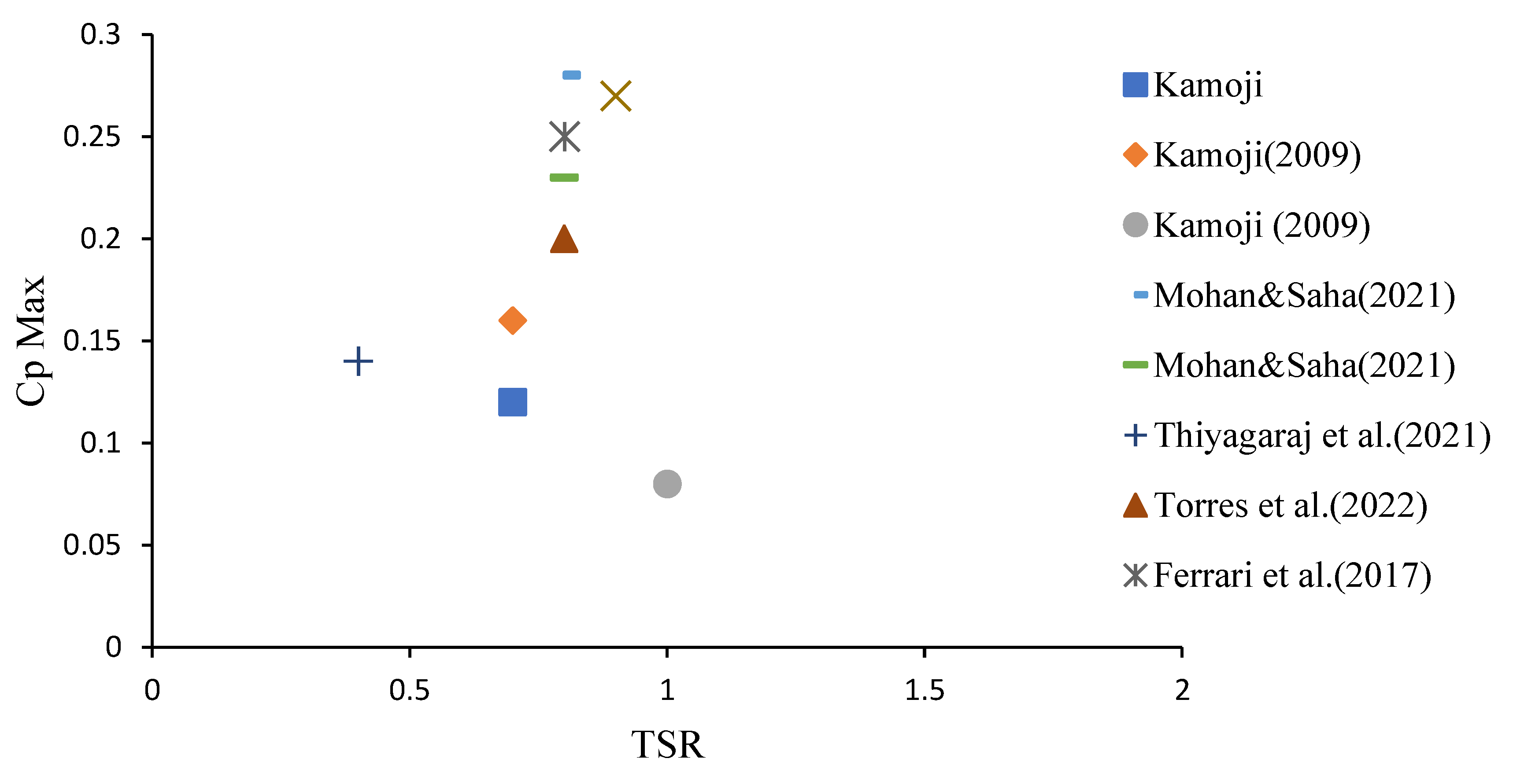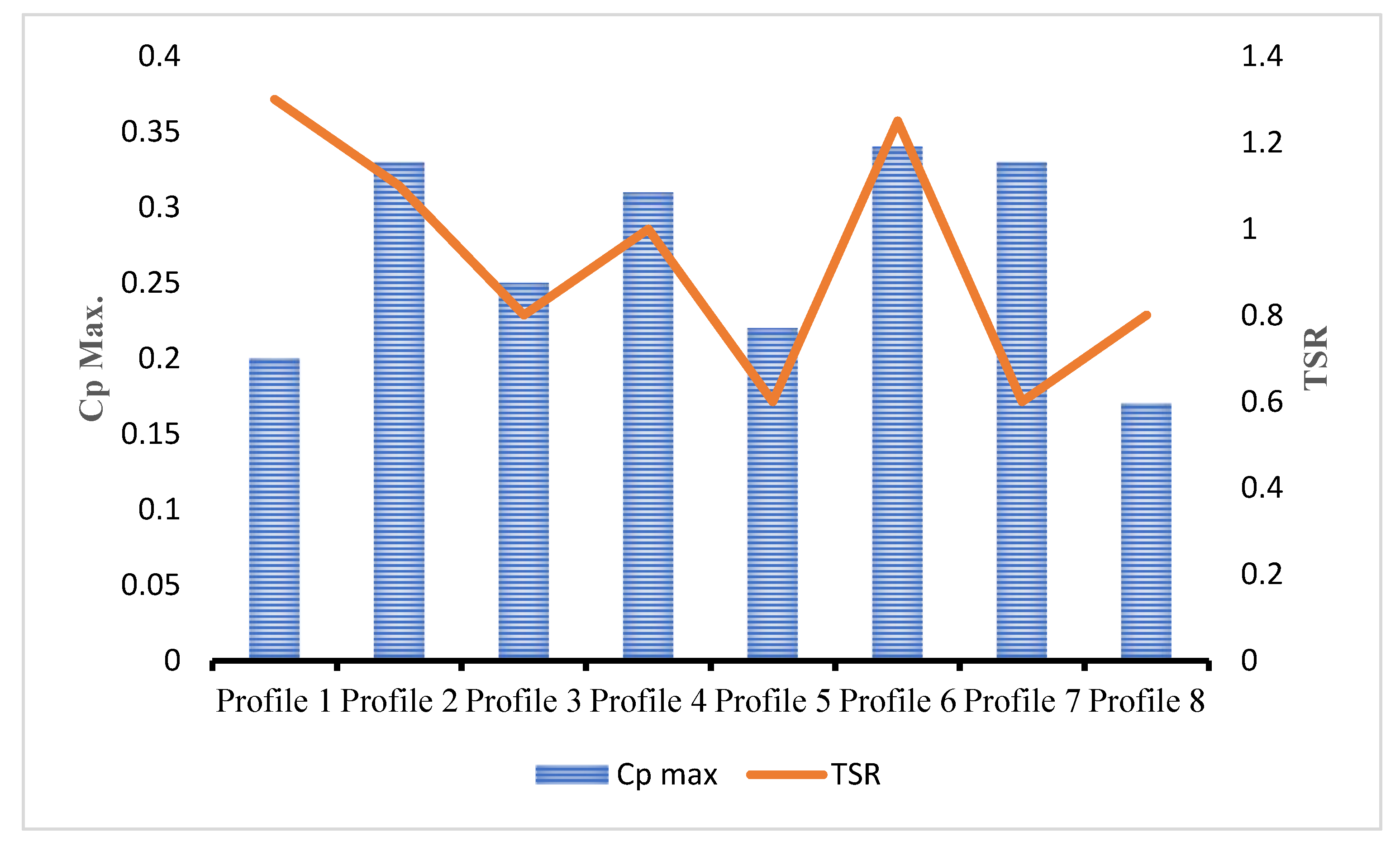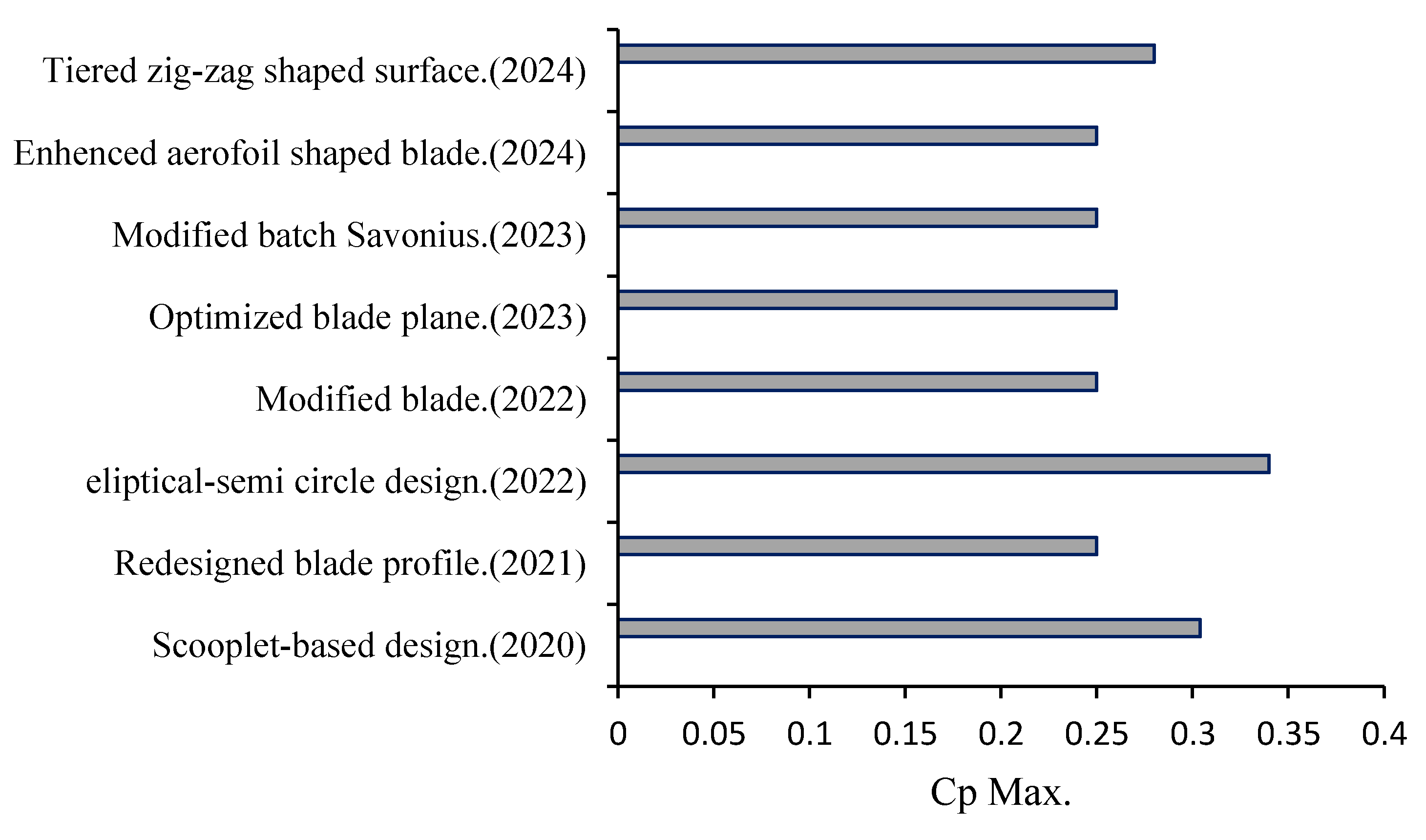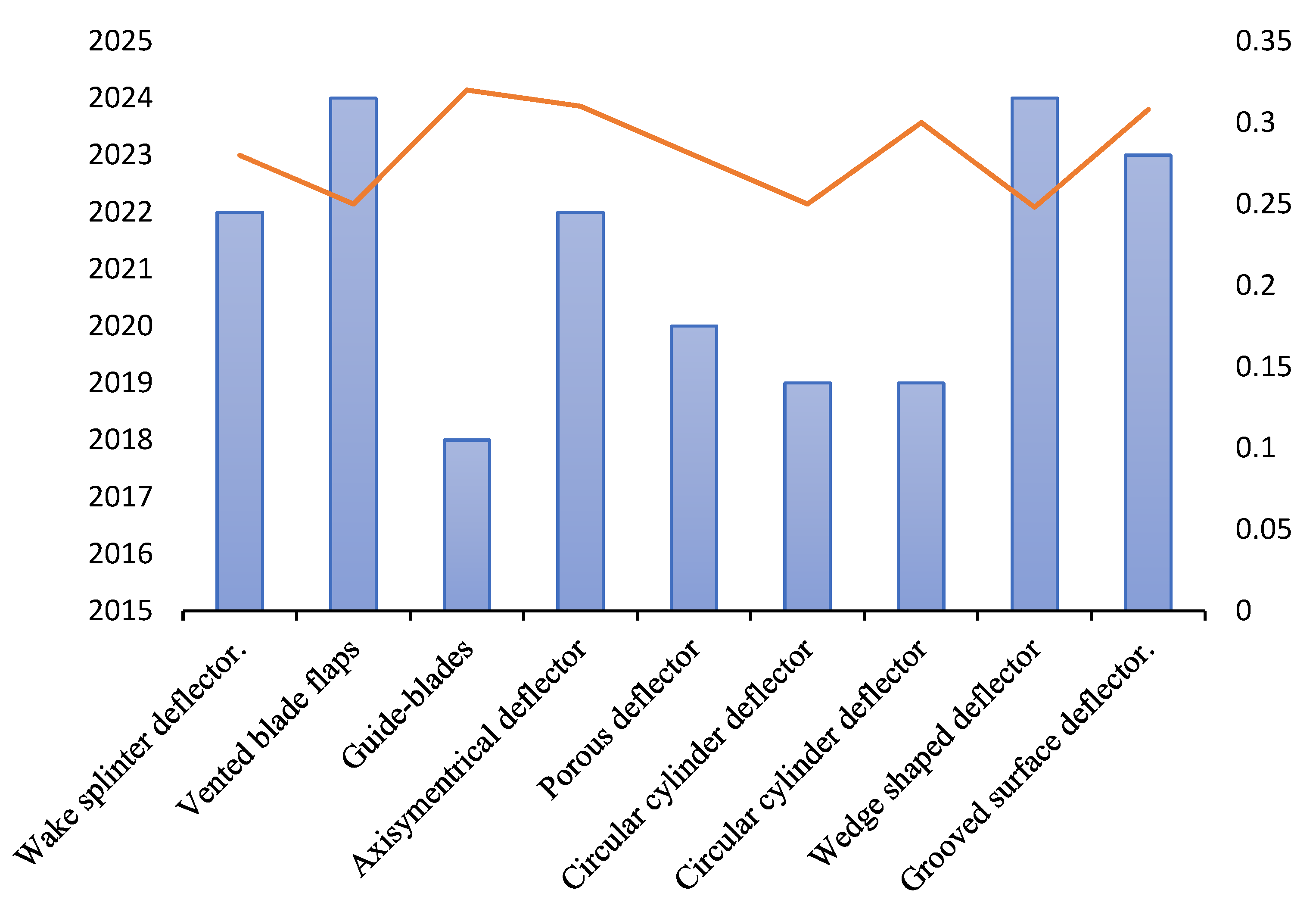Enhancing the Performance of Savonius Wind Turbines: A Review of Advances Using Multiple Parameters
Abstract
:1. Introduction

2. Drag-Based Wind Turbines
3. Geometric Properties
3.1. The Aspect (AR) and Overlap (OR) Ratios
3.2. Blade Profiles
3.3. Blade Arc
4. Performance Enhancement Techniques
4.1. Blade Profile Optimization for Improved Performance in Operation
4.2. Installation Effects
4.3. The Use of Deflectors in Reducing Negative Torque
4.4. Multistage Savonius System
5. Conclusions and Recommendations
Author Contributions
Funding
Acknowledgments
Conflicts of Interest
References
- Akinbami, O.M.; Oke, S.R.; Bodunrin, M.O. The State of Renewable Energy Development in South Africa: An Overview. Alex. Eng. J. 2021, 60, 5077–5093. [Google Scholar] [CrossRef]
- Szewczuk, S.; Prinsloo, E. Wind Atlas for South Africa (WASA): Project Overview and Current Status. In Proceedings of the Science Real and Relevant Conference, Pretoria, South Africa, 30 August–1 September 2010; pp. 1–10. [Google Scholar]
- Carsten, J.; Gylling, N.; Andrea, N.; Guo, X.; Mark, C. WASA International Collaboration as an Example of Reciprocal Skills Transfer through Wind Energy Development in South Africa. In Proceedings of the Windaba Conference, Cape Town International Convention Centre, Cape Town, South Africa, 4–5 November 2015. [Google Scholar]
- Wright, M.A.; Grab, S.W. Wind Speed Characteristics and Implications for: Wind Power Generation: Cape Regions, South Africa. S. Afr. J. Sci. 2017, 113, 8. [Google Scholar] [CrossRef]
- Prabowoputra, D.M.; Prabowo, A.R. Effect of the Phase-Shift Angle on the Vertical Axis Savonius Wind Turbine Performance as a Renewable-Energy Harvesting Instrument. Energy Rep. 2022, 8, 57–66. [Google Scholar] [CrossRef]
- Dewan, A.; Gautam, A.; Goyal, R. Savonius Wind Turbines: A Review of Recent Advances in Design and Performance Enhancements. Mater. Today Proc. 2021, 47, 2976–2983. [Google Scholar] [CrossRef]
- Noman, A.A.; Tasneem, Z.; Sahed, M.F.; Muyeen, S.M.; Das, S.K.; Alam, F. Towards next Generation Savonius Wind Turbine: Artificial Intelligence in Blade Design Trends and Framework. Renew. Sustain. Energy Rev. 2022, 168, 112531. [Google Scholar] [CrossRef]
- Hesami, A.; Nikseresht, A.H.; Mohamed, M.H. Feasibility Study of Twin-Rotor Savonius Wind Turbine Incorporated with a Wind-Lens. Ocean Eng. 2022, 247, 110654. [Google Scholar] [CrossRef]
- Sakti, G.; Yuwono, T. Numerical and experimental investigation of the effect of a circular cylinder as passive control on the savonius wind turbine performance. J. Southwest Jiaotong Univ. 2005, 56, 73–93. [Google Scholar] [CrossRef]
- Kamoji, M.A.; Kedare, S.B.; Prabhu, S.V. Experimental Investigations on Single Stage, Two Stage and Three Stage Conventional Savonius Rotor. Int. J. Energy Res. 2008, 32, 877–895. [Google Scholar] [CrossRef]
- Kamoji, M.A.; Kedare, S.B.; Prabhu, S.V. Performance Tests on Helical Savonius Rotors. Renew. Energy 2009, 34, 521–529. [Google Scholar] [CrossRef]
- Ferrari, G.; Federici, D.; Schito, P.; Inzoli, F.; Mereu, R. CFD Study of Savonius Wind Turbine: 3D Model Validation and Parametric Analysis. Renew. Energy 2017, 105, 722–734. [Google Scholar] [CrossRef]
- Torres, S.; Marulanda, A.; Montoya, M.F.; Hernandez, C. Geometric Design Optimization of a Savonius Wind Turbine. Energy Convers. Manag. 2022, 262, 115679. [Google Scholar] [CrossRef]
- Thiyagaraj, J.; Rahamathullah, I.; Anbuchezhiyan, G.; Barathiraja, R.; Ponshanmugakumar, A. Influence of Blade Numbers, Overlap Ratio and Modified Blades on Performance Characteristics of the Savonius Hydro-Kinetic Turbine. Mater. Today Proc. 2021, 46, 4047–4053. [Google Scholar] [CrossRef]
- Dewan, A.; Tomar, S.S.; Bishnoi, A.K.; Singh, T.P. Computational Fluid Dynamics and Turbulence Modelling in Various Blades of Savonius Turbines for Wind and Hydro Energy: Progress and Perspectives. Ocean Eng. 2023, 283, 115168. [Google Scholar] [CrossRef]
- Shamsuddin, M.S.; Kamaruddin, N.M. Experimental Study on the Characterization of the Self-Starting Capability of a Single and Double-Stage Savonius Turbine. Results Eng. 2023, 17, 100854. [Google Scholar] [CrossRef]
- Tata, M.; Bekhti, A.; Maizi, M.; Cherifi, M.O.; Tamoum, A.; Boudis, A.; Debbache, M.; Guerri, O. Aerodynamic Performance Investigations of Savonius Twin-Rotor Wind Turbines. J. Appl. Fluid Mech. 2024, 17, 442–460. [Google Scholar] [CrossRef]
- Hosseini, S.E.; Salehi, F. Analyzing Overlap Ratio Effect on Performance of a Modified Savonius Wind Turbine. Phys. Fluids 2023, 35, 125131. [Google Scholar] [CrossRef]
- Ebrahimpour, M.; Shafaghat, R.; Alamian, R.; Safdari Shadloo, M. Numerical Investigation of the Savonius Vertical Axis Wind Turbine and Evaluation of the Effect of the Overlap Parameter in Both Horizontal and Vertical Directions on Its Performance. Symmetry 2019, 11, 821. [Google Scholar] [CrossRef]
- Mohan, M.; Saha, U.K. Overlap Ratio as the Design Variable for Maximizing the Efficiency of a Savonius Wind Rotor: An Optimization Approach. In Proceedings of the ASME 2021 International Mechanical Engineering Congress and Exposition, Virtual, 1–5 November 2021; p. V08BT08A025. [Google Scholar]
- Mahesa Prabowoputra, D.; Hadi, S.; Sohn, J.M.; Prabowo, A.R. The Effect of Multi-Stage Modification on the Performance of Savonius Water Turbines under the Horizontal Axis Condition. Open Eng. 2020, 10, 793–803. [Google Scholar] [CrossRef]
- El-Askary, W.A.; Saad, A.S.; AbdelSalam, A.M.; Sakr, I.M. Investigating the Performance of a Twisted Modified Savonius Rotor. J. Wind Eng. Ind. Aerodyn. 2018, 182, 344–355. [Google Scholar] [CrossRef]
- Saad, A.S.; El-Sharkawy, I.I.; Ookawara, S.; Ahmed, M. Performance Enhancement of Twisted-Bladed Savonius Vertical Axis Wind Turbines. Energy Convers. Manag. 2020, 209, 112673. [Google Scholar] [CrossRef]
- Mu, Z.; Tong, G.; Xiao, Z.; Deng, Q.; Feng, F.; Li, Y.; Arne, G. Study on Aerodynamic Characteristics of a Savonius Wind Turbine with a Modified Blade. Energies 2022, 15, 6661. [Google Scholar] [CrossRef]
- Alom, N.; Saha, U.K. Influence of Blade Profiles on Savonius Rotor Performance: Numerical Simulation and Experimental Validation. Energy Convers. Manag. 2019, 186, 267–277. [Google Scholar] [CrossRef]
- Ashwindran, S.N.; Azizuddin, A.A.; Oumer, A.N. A Moment Coefficient Computational Study of Parametric Drag-Driven Wind Turbine at Moderate Tip Speed Ratios. Aust. J. Mech. Eng. 2022, 20, 433–447. [Google Scholar] [CrossRef]
- Shashikumar, C.M.; Honnasiddaiah, R.; Hindasageri, V.; Madav, V. Experimental and Numerical Investigation of Novel V-Shaped Rotor for Hydropower Utilization. Ocean Eng. 2021, 224, 108689. [Google Scholar] [CrossRef]
- Mao, Z.; Tian, W. Effect of the Blade Arc Angle on the Performance of a Savonius Wind Turbine. Adv. Mech. Eng. 2015, 7, 168781401558424. [Google Scholar] [CrossRef]
- Abdelaziz, K.R.; Nawar, M.A.A.; Ramadan, A.; Attai, Y.A.; Mohamed, M.H. Performance Investigation of a Savonius Rotor by Varying the Blade Arc Angles. Ocean Eng. 2022, 260, 112054. [Google Scholar] [CrossRef]
- Rengma, T.S.; Subbarao, P.M.V. Optimization of Semicircular Blade Profile of Savonius Hydrokinetic Turbine Using Artificial Neural Network. Renew. Energy 2022, 200, 658–673. [Google Scholar] [CrossRef]
- Marinić-Kragić, I.; Vučina, D.; Milas, Z. Computational Analysis of Savonius Wind Turbine Modifications Including Novel Scooplet-Based Design Attained via Smart Numerical Optimization. J. Clean. Prod. 2020, 262, 121310. [Google Scholar] [CrossRef]
- Sumiati, R.; Dinata, U.; Saputra, D. Enhancing the Performance of Savonius Rotor Using Tiered-Height Zigzag Patterns in Concave Surface. J. Appl. Eng. Sci. 2024, 22, 113–122. [Google Scholar] [CrossRef]
- Mat Yazik, M.H.; Zawawi, M.H.; Ahmed, A.N.; Sidek, L.M.; Basri, H.; Ismail, F. One-Way Fluid Structure Interaction Analysis of a Static Savonius Hydrokinetic Turbine under Different Velocity and Surface Roughness with Different Blade Materials. Ocean Eng. 2024, 291, 116373. [Google Scholar] [CrossRef]
- Al-Gburi, K.A.H.; Alnaimi, F.B.I.; Al-quraishi, B.A.J.; Tan, E.S.; Kareem, A.K. Enhancing Savonius Vertical Axis Wind Turbine Performance: A Comprehensive Approach with Numerical Analysis and Experimental Investigations. Energies 2023, 16, 4204. [Google Scholar] [CrossRef]
- Tomar, S.S.; Dewan, A.; Singh, T.P. Effects of Axisymmetric-Omnidirectional Deflector on Aerodynamics of Modified Bach Savonius Rotor for Power Enhancement. Energy Convers. Manag. 2023, 297, 117720. [Google Scholar] [CrossRef]
- Dinh Le, A.; Nguyen Thi Thu, P.; Ha Doan, V.; The Tran, H.; Duc Banh, M.; Truong, V.-T. Enhancement of Aerodynamic Performance of Savonius Wind Turbine with Airfoil-Shaped Blade for the Urban Application. Energy Convers. Manag. 2024, 310, 118469. [Google Scholar] [CrossRef]
- Goodarzi, M.; Hamzeh, M. Numerical Study on Power Generation versus Force Fluctuation of Two Side-by-Side Savonius Rotors. Ocean Eng. 2024, 296, 117086. [Google Scholar] [CrossRef]
- Meziane, M.; Essadiqi, E.; Faqir, M. CFD Study of Unsteady Flow Through Savonius Wind Turbine Clusters. Int. J. Renew. Energy Res. 2019, 9, 657–666. [Google Scholar] [CrossRef]
- Etemadeasl, V.; Esmaelnajad, R.; Farzaneh, B.; Jafari, M. Application of Counter Rotating Rotors for Improving Performance of Savonius Turbines. Iran J. Sci. Technol. Trans. Mech. Eng. 2021, 45, 473–485. [Google Scholar] [CrossRef]
- Altan, B.D.; Gungor, A. Examination of the Effect of Triangular Plate on the Performances of Reverse Rotating Dual Savonius Wind Turbines. Processes 2022, 10, 2278. [Google Scholar] [CrossRef]
- Im, H.; Kim, B. Power Performance Analysis Based on Savonius Wind Turbine Blade Design and Layout Optimization through Rotor Wake Flow Analysis. Energies 2022, 15, 9500. [Google Scholar] [CrossRef]
- Kalluvila, J.B.S.; Sreejith, B. Numerical and Experimental Study on a Modified Savonius Rotor with Guide Blades. Int. J. Green Energy 2018, 15, 744–757. [Google Scholar] [CrossRef]
- Aboujaoude, H.; Beaumont, F.; Murer, S.; Polidori, G.; Bogard, F. Aerodynamic Performance Enhancement of a Savonius Wind Turbine Using an Axisymmetric Deflector. J. Wind Eng. Ind. Aerodyn. 2022, 220, 104882. [Google Scholar] [CrossRef]
- Mohammadi, M.; Mohammadi, R.; Ramadan, A.; Mohamed, M.H. Numerical Investigation of Performance Refinement of a Drag Wind Rotor Using Flow Augmentation and Momentum Exchange Optimization. Energy 2018, 158, 592–606. [Google Scholar] [CrossRef]
- Eshagh Nimvari, M.; Fatahian, H.; Fatahian, E. Performance Improvement of a Savonius Vertical Axis Wind Turbine Using a Porous Deflector. Energy Convers. Manag. 2020, 220, 113062. [Google Scholar] [CrossRef]
- Setiawan, P.A.; Yuwono, T.; Widodo, W.A.; Julianto, E.; Santoso, M. Numerical Study of a Circular Cylinder Effect on the Vertical Axis Savonius Water Turbine Performance at the Side of the Advancing Blade with Horizontal Distance Variations. Int. J. Renew. Energy Res. 2019, 9, 978–985. [Google Scholar]
- Setiawan, P.A.; Yuwono, T.; Lukitadi, P.P.S.; Santoso, E.; Ariwiyono, N.; Shah, M.; Antoko, B.; Prasojo, B.; Purwanti, E.P.; Hidayat, E.P. Experimental Investigation of Cylinder Rotation Effect on the Advancing Side to Savonius Wind Turbine Performance. Int. J. Mech. Eng. Robot. Res. 2023, 12, 284–289. [Google Scholar] [CrossRef]
- Fatahian, E.; Ismail, F.; Hafifi Hafiz Ishak, M.; Shyang Chang, W. An Innovative Deflector System for Drag-Type Savonius Turbine Using a Rotating Cylinder for Performance Improvement. Energy Convers. Manag. 2022, 257, 115453. [Google Scholar] [CrossRef]
- Fatahian, E.; Ismail, F.; Ishak, M.H.H.; Chang, W.S. The Role of Wake Splitter Deflector on Performance Enhancement of Savonius Wind Turbine. Phys. Fluids 2022, 34, 095111. [Google Scholar] [CrossRef]
- Fatahian, E.; Ismail, F.; Ishak, M.H.H.; Chang, W.S. Aerodynamic Performance Improvement of Savonius Wind Turbine through a Passive Flow Control Method Using Grooved Surfaces on a Deflector. Ocean Eng. 2023, 284, 115282. [Google Scholar] [CrossRef]
- Fatahian, H.; Mohamed-Kassim, Z. Two-Stage Taguchi-Based Optimization on Dynamically-Vented Blade Flaps to Enhance the Rotor Performance of a Savonius Turbine. Ocean Eng. 2024, 300, 117283. [Google Scholar] [CrossRef]
- Singh, O.; Saini, G.; De, A. Hydrodynamic Performance Enhancement of Savonius Hydrokinetic Turbine Using Wedge-Shaped Triangular Deflector in Conjunction with Circular Deflector. Ocean Eng. 2024, 292, 116572. [Google Scholar] [CrossRef]
- Ghafoorian, F.; Mirmotahari, S.R.; Wan, H. Numerical Study on Aerodynamic Performance Improvement and Efficiency Enhancement of the Savonius Vertical Axis Wind Turbine with Semi-Directional Airfoil Guide Vane. Ocean Eng. 2024, 307, 118186. [Google Scholar] [CrossRef]
- Mahesa Prabowoputra, D.; Krisnawati, M.; Sari Nurhidayat, A.R.; Khosyi, M.; Febrian Nur Halim, R.; Zumara, H. CFD Analysis of The Stage-Ratio Factor on Savonius Wind Turbine Performance to Optimize Clean-Energy Conversion. E3S Web Conf. 2023, 465, 01007. [Google Scholar] [CrossRef]
- Patel, U.K.; Alom, N.; Saha, U.K. Aerodynamic Analysis of a 2-Stage Elliptical-Bladed Savonius Wind Rotor: Numerical Simulation and Experimental Validation. Int. J. Green Energy 2024, 21, 102–115. [Google Scholar] [CrossRef]
- Xiong, B.; Wang, H.; Wang, L.; Zhang, Z.; Pan, Y.; Liu, T.; Tang, M.; Liu, G.; Hu, Y. Sustainable Wind Barrier: Self-Powered System for High-Speed Railway Safety Monitoring. Sustain. Mater. Technol. 2024, 39, e00848. [Google Scholar] [CrossRef]
- Kothe, L.B.; Möller, S.V.; Petry, A.P. Numerical and Experimental Study of a Helical Savonius Wind Turbine and a Comparison with a Two-Stage Savonius Turbine. Renew. Energy 2020, 148, 627–638. [Google Scholar] [CrossRef]
- Laws, P. Validating the Ideal Configuration and Mutual Coupling Effect among Savonius Wind Turbine Clusters Using Free Rotation Analysis. Ocean Eng. 2022, 266, 112879. [Google Scholar] [CrossRef]
- Shonhiwa, C.; Makaka, G.; Mukumba, P.; Shambira, N. Investigation of Wind Power Potential in Mthatha, Eastern Cape Province, South Africa. Appl. Sci. 2023, 13, 12237. [Google Scholar] [CrossRef]





| Reference | Description | Self-Starting Ability | Enhancement | Gap |
|---|---|---|---|---|
| [19] | Inward and outward overlaps | Not tested | The Cp improved by 3.7% and 7.5% for the horizontal and vertical overlaps, respectively. | Investigation of tensile forces on the rotor. |
| [13] | A novel SWT design method | Not tested | Max. peak power of 0.21. | Validation of results obtained. |
| [18] | OR effect on the performance | Not tested | A Cp of 0.263 and 0.293 for SR3345 and SR5050, respectively. | - |
| [17] | Aerodynamic performance investigation | Not tested | An 80% increase in the power coefficient. | Validation and wake analysis. |
| [22] | Twisted blade profile | Not tested | Max. peak power of 0.22. | - |
| [27] | V-shaped rotor | Not tested | A 19% increase in the power coefficient. | Validation of the results experimentally. |
| [29] | Blade arc | Not tested | A 12.9% increase in the power coefficient. | Further optimization of the design variables. |
| [30] | Blade optimization using AI | Not tested | Max. peak power of 0.194. | Encouragement for future studies to use AI as another optimization tool. |
| Reference | Description. | Self-Starting Ability. | Enhancement. | Gap for Future Work. |
|---|---|---|---|---|
| [31] | Novel scooplet blade design | Not tested | Peak power is 39% higher than the classical SWT. | Enhancement and testing of the self-starting capacity. |
| [32] | Tiered zig-zag pattern on the concave side of the SWT | Not tested | A 16% increase in the power coefficient. | Testing of more patterns on the concave blade of the SWT. |
| [34] | Blade profile modification | Not tested | A 22.8% increase in the power coefficient. | Development of hybrid systems with other blade profiles or VAWTs. |
| [35] | Number of blades and cowl | Not tested | An 8.78% power coefficient improvement by adding a deflector. | Enhancement and testing of the self-starting capacity. |
| [38]. | Spatial distribution of the SWT | Not tested | Backward oblique setup has 3 times the power coefficient of an isolated rotor. | Evaluating different turbine system setups. |
| [40] | V-plate deflector | Not tested | A 30% increase in the power coefficient. | Modification of the system for changing the wind direction. |
| [49] | Wake splitter deflector | Not tested | A 15% increase in the power coefficient. | Enhancement and testing of the self-starting capacity. |
| [55] | Multistage turbine system | Not tested | A 14.44% increase in the power coefficient. | Investigation of an augmentation device that can be used with this multistage turbine. |
| [41] | Cluster arrangement | Not tested | A 28% increase in the power coefficient. | A cluster with a yaw mechanism relative to the upstream turbine. |
| [42] | Rotor guide blades | Not tested | Peak power of 0.32. | - |
| [44] | Nozzle-augmentation system | Not tested | Peak power of 0.39. | Different augmentation shapes. |
| [45] | Porous deflector | Doubled the static torque | A 28% increase in the power coefficient. | Include inter-parameter interactions. |
| [46] | Numerical cylinder deflector | Not tested | A 17.31% increase in the power coefficient. | Smoothing diverted the wind flow. |
| [21] | Multistage rotor | Not tested | Peak power of 0.29. | Testing of different blade profiles. |
| [57] | Multistage helical turbine | Positive static torque from 0° to 90° | A 9.25% Cp gain compared to other multistage systems. | Numerical method can be applied in future work. |
| [16] | Multistage Savonius wind turbine | Positive static torque in all angles; improved self-starting | A 138% increase in the power coefficient. | Establishment of upper limit for turbines. |
| [51] | Active flap turbine blades | Not tested | A 21% increase in the power coefficient. | Using overset meshing to avoid gaps on the flaps. |
| [50] | Rotating cylinder deflector | Not tested | A 23.2% increase in the power coefficient. | Use of a U-shaped deflector. |
| [23] | Twisted blade profile | Positive static torque on all directions | Peak power of 0.31. | Reducing the structural load for a better Cp. |
| [5] | Multistage Savonius wind turbine | Not tested | Peak power of 0.29. | Investigation of other blade profiles. |
| [58] | Cluster arrangement | Not tested | - | A cluster with a yaw mechanism. |
| [47] | Experimental rotating cylinder deflector | Not tested | A 66.193% increase in the power coefficient. | Smoothing diverted the wind flow. |
Disclaimer/Publisher’s Note: The statements, opinions and data contained in all publications are solely those of the individual author(s) and contributor(s) and not of MDPI and/or the editor(s). MDPI and/or the editor(s) disclaim responsibility for any injury to people or property resulting from any ideas, methods, instructions or products referred to in the content. |
© 2024 by the authors. Licensee MDPI, Basel, Switzerland. This article is an open access article distributed under the terms and conditions of the Creative Commons Attribution (CC BY) license (https://creativecommons.org/licenses/by/4.0/).
Share and Cite
Chitura, A.G.; Mukumba, P.; Lethole, N. Enhancing the Performance of Savonius Wind Turbines: A Review of Advances Using Multiple Parameters. Energies 2024, 17, 3708. https://doi.org/10.3390/en17153708
Chitura AG, Mukumba P, Lethole N. Enhancing the Performance of Savonius Wind Turbines: A Review of Advances Using Multiple Parameters. Energies. 2024; 17(15):3708. https://doi.org/10.3390/en17153708
Chicago/Turabian StyleChitura, Anesu Godfrey, Patrick Mukumba, and Ndanduleni Lethole. 2024. "Enhancing the Performance of Savonius Wind Turbines: A Review of Advances Using Multiple Parameters" Energies 17, no. 15: 3708. https://doi.org/10.3390/en17153708





